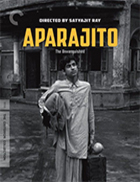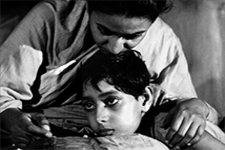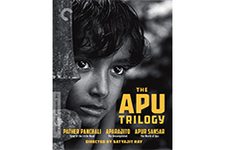| Director: Satyajit Ray | | Screenplay: Satyajit Ray (based on the novels Pather Panchali and Aparajito by Bibhutibhushan Bandyopadhyay) | | Stars: Kanu Banerjee (Harihar, Apu’s father), Karuna Banerjee (Sarbajaya, Apu’s mother), Smaran Ghosal (Adolescent Apu), Pinaki Sengupta (Young Apu ), Ramani Sengupta (Bhabataran, Sarbajaya’s uncle), Charuprakash Ghosh (Nanda-babu, upstairs neighbor), Subodh Ganguli (Headmaster), Moni Srimani (School inspector), Hemanta Chatterjee (Schoolteacher), Ranibala (Teli, Bhabataran’s patron), Sudipta Roy (Nirupama, Teli’s daughter), Ajay Mitra (Shibnath, Apu’s schoolmate), Kali Banerjee (Kalicharan, Harihar’s guest), Kalicharan Roy (Akhil, press proprietor) | | MPAA Rating: NR | | Year of Release: 1956 | | Country: India |  |
|  Aparajito (The Unvanquished), the middle film in Satyajit Ray’s “Apu Trilogy,” picks up right where Pather Panchali (1955) left off. Having lost their adolescent daughter to illness, the Ray family—father Harihar (Kanu Banerjee), mother Sarbajaya (Karuna Banerjee), and young Apu (Smaran Ghosal)—leave their ancestral home in a small Bengali village and move to the north Indian city of Varanasi, on the banks of the Ganges. The final image of Pather Panchali was the family huddled in a small horse-drawn wagon, moving off into an uncertain future, which is surely where the story would have ended had the film not become a massive critical success around the world, positioning Ray, a first-time director, as not just a new auteur, but one that gave voice to an otherwise cinematically unrepresented part of the world. Following up the popular film with a sequel was something of a no-brainer, given that it hadn’t covered all of the material in Bibhutibhushan Bannerjee’s source novel. Ray’s adaptation ended up drawing from the last third of Bannerjee’s novel and the first third of his sequel, also titled Aparajito, although Ray drew heavily from his own personal experiences, making the film particularly autobiographical. Aparajito is divided into two halves. The first half takes place in Varanasi, where Apu is still close in age to what he was in Pather Panchali (8 or 9 years old). He is still a bright-eyed, mischievous child, although now he lives in a world of concrete and stone, rather than the rural forest that had been his home. Tall buildings, alleyways, and paved streets replace trees, fields, and streams. Steam trains, the sight of which was so monumental and life rattling in Pather Panchali, are a regular feature of the urban landscape. Aparajito is very much about the transition from a rural to an urban life and the effects it has on Apu and his parents (most directly, we see a jadedness creeping into Apu, as the delight he took in various forms of rural entertainment is largely gone). The Ray family is still struggling financially, but life seems somewhat more balanced than it was when they were living in Bengal. One of the main issues is Apu’s education, as Sarbajaya wants him to attend a good school so he can break out of the cycle of poverty into which he was born. However, as it did at the end of Pather Panchali, tragedy strikes the family, leaving it further broken. The second half of the film picks up with Apu as a 17-year-old (Pinaki Sengupta) who has excelled in school and has won a scholarship to further his studies in Calcutta. This would mean he would have to leave his family in Varanasi, something that Sarbajaya is at first adamantly against, although she eventually relents as she recognizes that otherwise Apu will not be able to transcend the limited material circumstances of his childhood. In Calcutta he gets a job as an apprentice to a printer, who gives him a place to stay and a salary. Balancing his work and his studies is difficult, a problem that is compounded by Sarbajaya’s desire for him to return home whenever possible. If the first half of the film is about the transition from a rural to an urban life, the second half is about Apu breaking away from his family to become his own man, which necessarily entails no small amount of heartbreak. Just as Pather Panchali features the deaths of two major characters, so does Aparajito, with the second having a particularly devastating effect on Apu because it essentially recreates his own father’s tragedy of not being present when his daughter died. The lure of personal independence and intellectual success draws Apu further and further away from his family and from the values that defined his childhood (where he lived in an ancestral home, a powerful symbol of generational connection). His intellectual and social betterment turns into a kind of Faustian bargain that eventually takes its toll. The film’s urban environment was more familiar to Ray, as he had grown up in Calcutta, living in a room over his grandfather’s printing shop, and Aparajito has an unassuming, lived-in quality that draws from and builds on Pather Panchali’s neorealist roots. In simple, lyrical shots, Ray conveys the enormity of living in a large, crowded city without losing sight of the simple beauties to be found all around. However, the film is most powerful in its depiction of the changing relationship between Apu and his mother as Apu grows into his own man. As portrayed by Pinaki Sengupta, Apu as a teenager-on-the-verge-of-manhood is a tall, gangly, largely quiet young man whose move to Calcutta commences a flowering that ultimately comes to the expense of his connection to his mother. Sarbajaya saves money to fund her only son’s education and makes sacrifices to ensure his success, yet she is left further and further behind. Apu’s letters become more and more infrequent, as do his visits, which is what makes his final trip home such an emotionally rending experience. As Pather Panchali had ended with the family, now partial, leaving their ancestral village, Aparajito ends with Apu returning to Calcultta alone, thus beginning adulthood in a tragic state of freedom. | Aparajito Criterion Collection 4K UHD + Blu-ray |  Aparajito is available as part of The Criterion Collection’s “The Apu Trilogy” 4K UHD + Blu-ray boxset, which also includes Pather Panchali (1955) and Apur Sansar (1959). Aparajito is available as part of The Criterion Collection’s “The Apu Trilogy” 4K UHD + Blu-ray boxset, which also includes Pather Panchali (1955) and Apur Sansar (1959). | | Aspect Ratio | 1.37:1 | | Audio | Bengali Linear PCM 1.0 monaural | | Subtitles | English | | Supplements | Audio recordings from 1958 of director Satyajit Ray reading his essay “A Long Time on the Little Road” and in conversation with film historian Gideon BachmannVideo interviews with actor Soumitra ChatterjeeVideo interview with actor Shampa SrivastavaVideo interview with actor Sharmila TagoreVideo interview with camera assistant Soumendu RoyVideo interview with film writer Ujjal Chakraborty“Making The Apu Trilogy: Satyajit Ray’s Epic Debut,” video essay by Ray biographer Andrew Robinson “The Apu Trilogy: A Closer Look,” program featuring filmmaker, producer, and teacher Mamoun HassanExcerpts from the 2003 documentary The Song of the Little Road, featuring composer Ravi ShankarThe Creative Person: “Satyajit Ray” a 1967 half-hour documentaryFootage of Ray receiving an honorary Oscar in 1992Programs on the restorations by filmmaker :: kogonadaInsert booklet featuring essays by critics Terrence Rafferty and Girish Shambu, as well as a selection of Ray’s storyboards for Pather Panchali | | Distributor | The Criterion Collection | | Release Date | January 2, 2024 | | | COMMENTS | | In her 1967 essay “Movies on Television,” which happened to be her debut essay in The New Yorker, Pauline Kael lamented how the availability of movies on television, with its low resolution and tiny screens, was diminishing the movie past. She noted how, on television, certain movies lose “much of what made them worth looking at,” a specific example of which was “the lyricism of Satyajit Ray.” Well, if Kael had lived long enough to see Criterion’s 4K digital restorations of “The Apu Trilogy,” which was undertaken in collaboration with the Academy Film Archive at the Academy of Motion Picture Arts and Sciences and L’Immagine Ritrovata in Bologna, Italy, she might retract her statement since every nuance of Ray’s lyricism in these beautiful films is fully preserved in these beautiful transfers. Criterion The restoration of the three Apu films was a massive endeavor years in the making. Back in 1993, the original camera negatives for all three films were sent to an archive in London where restoration was to begin. Unfortunately, a fire broke out in the archive and all three films suffered serious fire damage, with Apur Sansar being completely destroyed. When Criterion initiated the restoration of the films, they started with the burned remnants of the negatives, which the restoration experts at L’Immagine Ritrovata were able to salvage by rehydrating the celluloid and physically repairing by elements that could be salvaged by hand. In the end, after hundreds of hours of manual labor, 40% of Pather Panchali’s negative and 60% of Aparajito’s negative could be used for wet-gate scanning. The damaged portions were replaced after an exhaustive search of the world’s archives turned up high-quality fine-grain masters and duplicate negatives. In the case of Apur Sansar, the entire film was scanned from a fine-grain master and a duplicate negative. Criterion originally released all three films on Blu-ray back in 2015, and now we have them in their full 2160p glory on 4K UHD. The images on these new discs derive from the same 4K scans from the restored elements, which were then given additional digital restoration over an 8-month period to remove dirt, damage, and audio artifacts. Given that these films were almost lost completely, it is pretty much miraculous how good they look, with a consistency of presentation that erases any evidence of how pieced-together they really are. Granted, they don’t look perfect, and to expect perfection is simply obtuse. Most signs of age and wear have been removed, although there are still the occasional hairlines and a few shots with significant scratching. The images are beautifully rendered in terms of contrast and grayscale, with outstanding detail that will amaze those who have become accustomed to seeing the films in low-resolution transfers from old, worn elements (comparisons to the previously available DVDs doesn’t even seem fair, and the jump from 2K to 4K is noticeable). The sound has been cleaned up substantially, even though there is a slight auditory hiss, especially in Pather Panchali, though it is hardly distracting. Each film in the trilogy improves in terms of technical quality, as Ray worked with increasingly bigger budgets and from a position of greater experience, but they all look fantastic, especially when you know all that they have been through. All of the supplements from the 2015 Blu-ray set are included here, which amounts to several hours of material that contextualize the films historically, culturally, and aesthetically. Ray, who passed away in 1992, is present in several supplements. There is an audio recording from 1958 of him reading his essay “A Long Time on the Little Road,” which documents the production of Pather Panchali, and a recording of him in conversation with film historian Gideon Bachmann. Ray also appears in a 1967 episode of the PBS half-hour documentary series The Creative Person by documentarian James Beveridge, who traveled to Calcutta to interview Ray, several of his actors, members of his creative team, and film critic Chidananda Das Gupta. We also get footage of him receiving the honorary Lifetime Achievement Oscar in 1992, just a few weeks before he died (he wasn’t able to attend the ceremony, so he appeared via video from his hospital bed). There are also several new video interviews with his collaborators, including actors Soumitra Chatterjee, Shampa Srivastava, and Sharmila Tagore and camera assistant Soumendu Roy, as well as excerpts from the 2003 documentary The Song of the Little Road that feature composer Ravi Shankar, who scored all three films. For a critical and historical look at the films, we have a new interview with film writer Ujjal Chakraborty; “Making The Apu Trilogy: Satyajit Ray’s Epic Debut,” a new video essay by Ray biographer Andrew Robinson; and “The Apu Trilogy: A Closer Look,” a new program featuring filmmaker, producer, and teacher Mamoun Hassan. Finally, there is a new program on the restoration of the three films by filmmaker :: kogonada (included is both a short version, used to promote the trilogy’s theatrical release in 2015, and a longer version exclusive to the Criterion box-set), and a thick insert booklet featuring essays by critics Terrence Rafferty and Girish Shambu, as well as a selection of Ray’s storyboards for Pather Panchali. |
Copyright © 2024 James Kendrick Thoughts? E-mail James Kendrick All images copyright © The Criterion Collection |




 (4)
(4)

 Aparajito is available as part of The Criterion Collection’s “The Apu Trilogy” 4K UHD + Blu-ray boxset, which also includes Pather Panchali (1955) and Apur Sansar (1959).
Aparajito is available as part of The Criterion Collection’s “The Apu Trilogy” 4K UHD + Blu-ray boxset, which also includes Pather Panchali (1955) and Apur Sansar (1959).